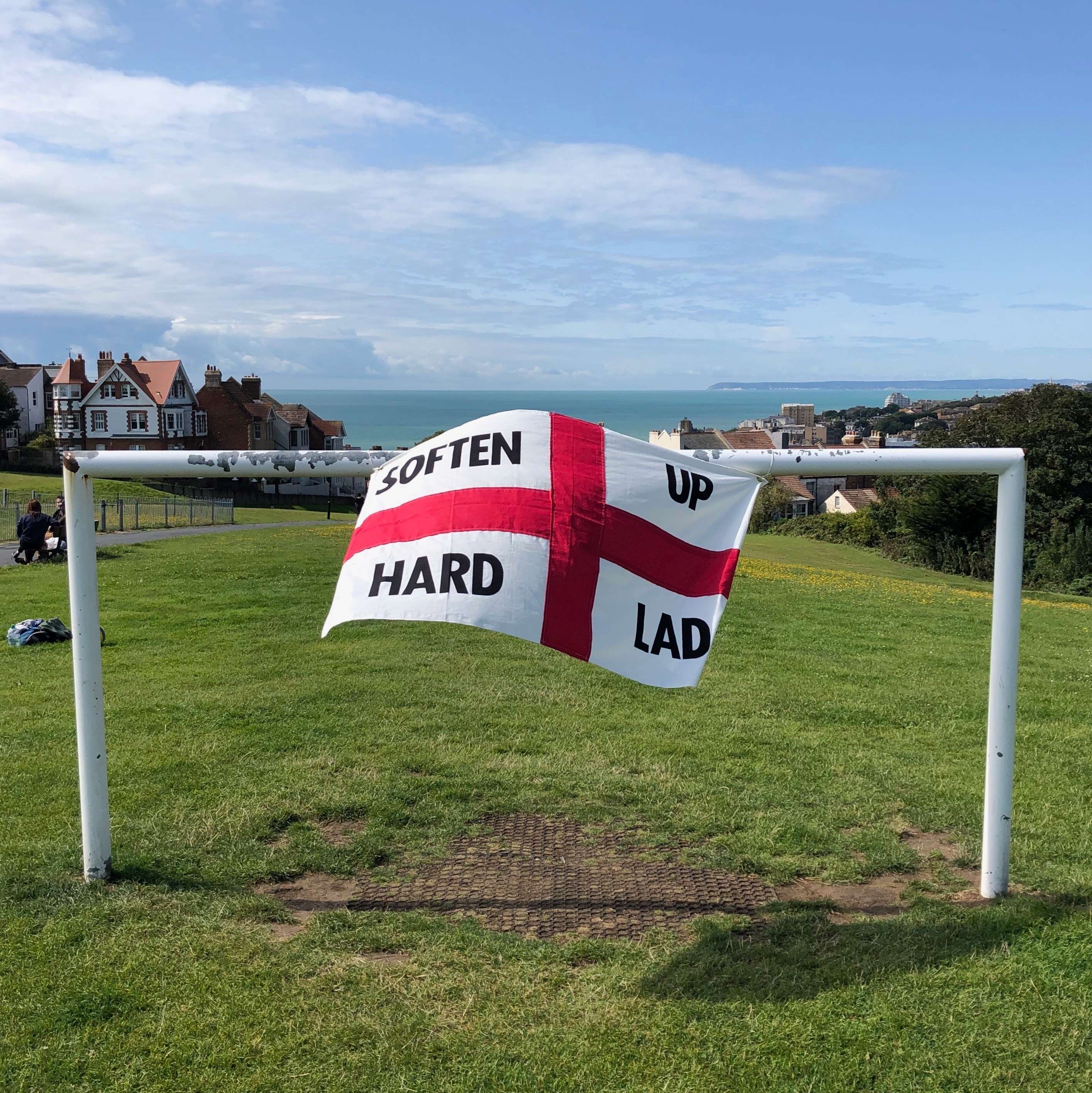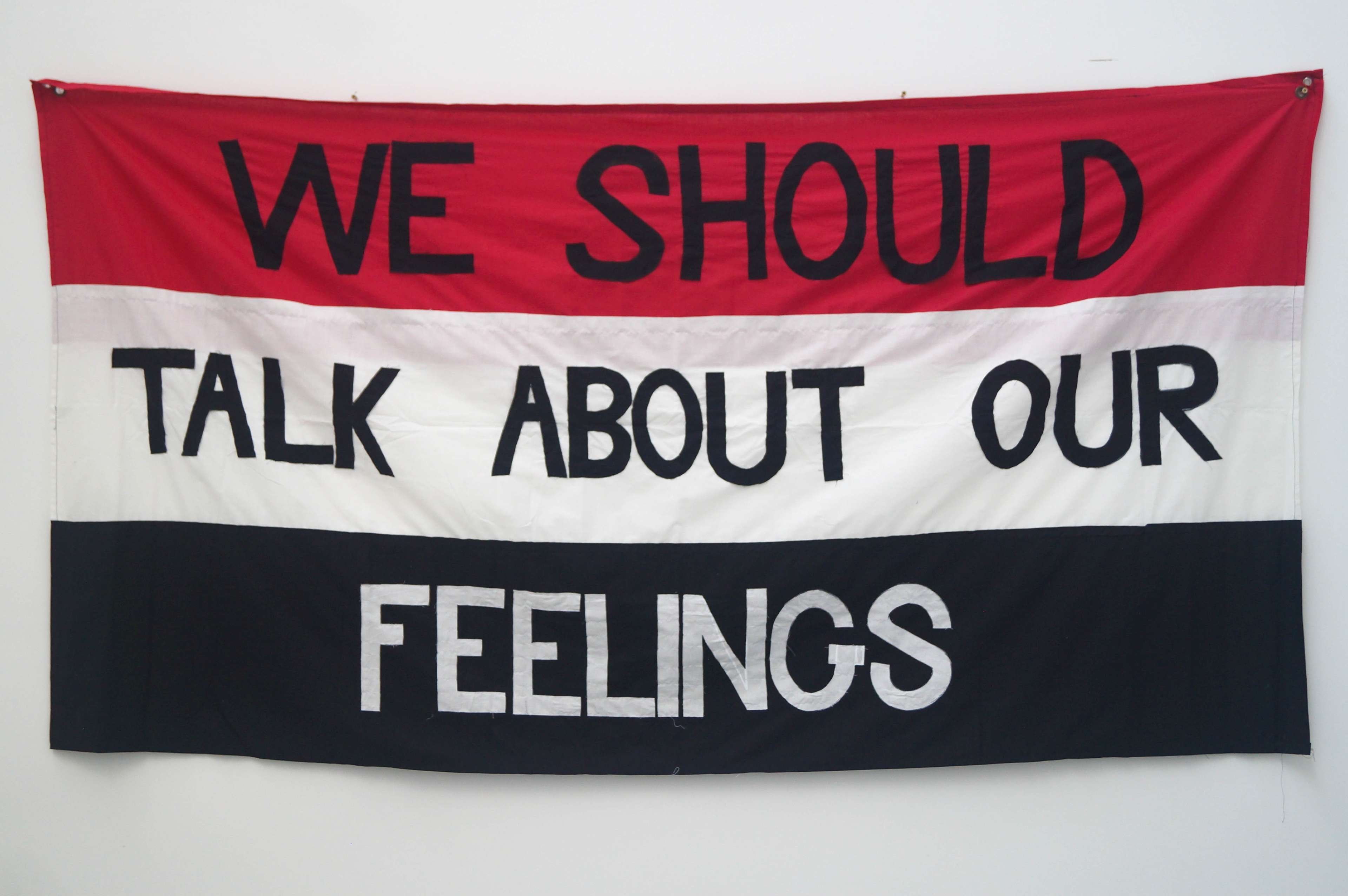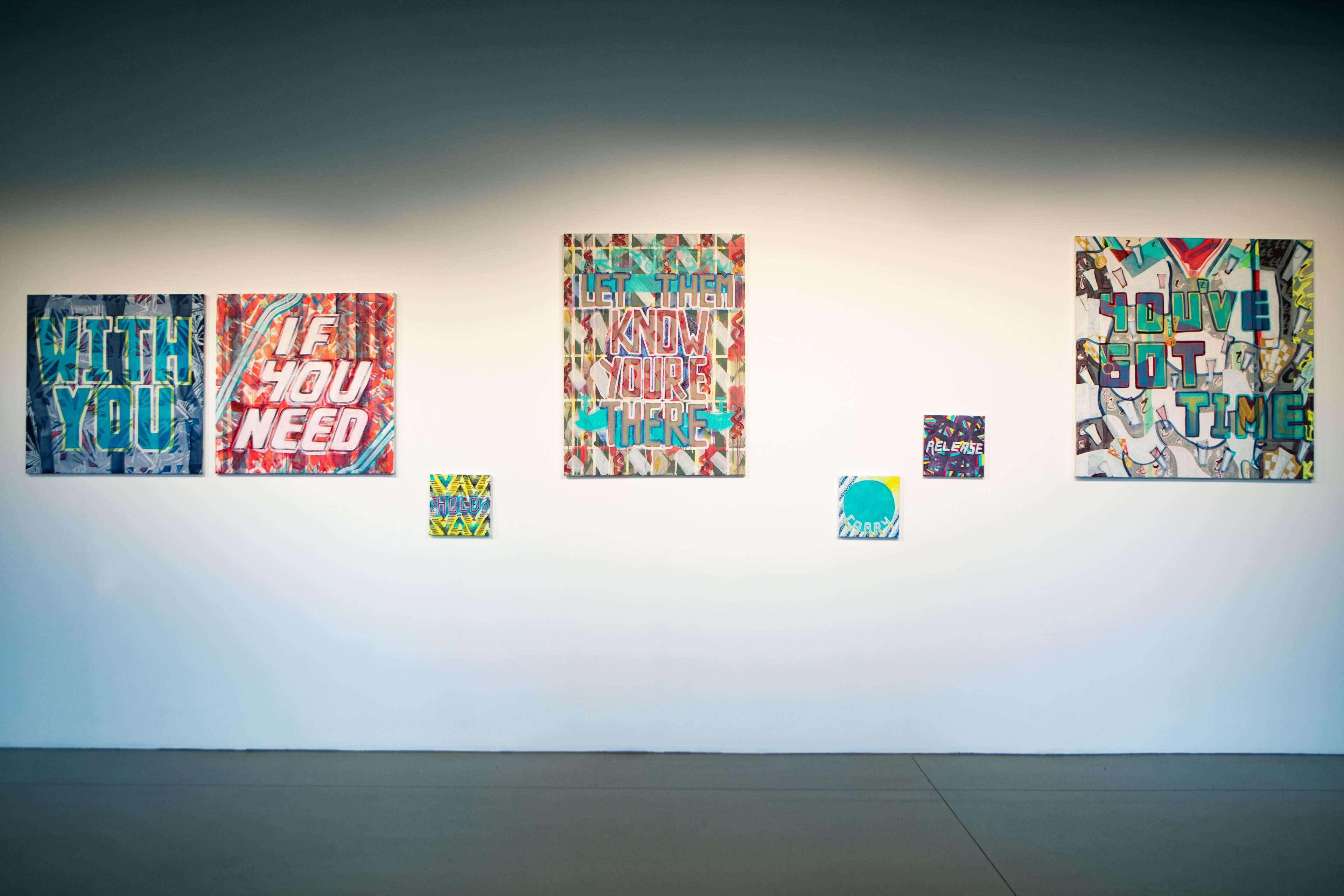2022 marks the year of the UEFA Women's Euro and the FIFA Men’s World Cup. All this week, VICE and GOAL will be collaborating to publish insightful, interesting stories from the world of football and fan culture, introducing VICE fans to GOAL and GOAL fans to VICE.
“We should talk about our feelings,” isn’t the kind of sentiment you usually find in football grounds.
The chants, flags and hurled expletives of the terraces and stands usually have more to do with kicking rival fans' heads in than dealing with emotions.
But it is the kind of sentiment you find in the work of the artist Corbin Shaw.
He’s hand-stitched those words onto a football flag, alongside St George’s Crosses emblazoned with phrases like ‘Soften Up Hard Lad’ and ‘Sweet & Tender Hooligan’.
And he’s not alone; just one of a growing number of young artists working today who use football as a way of confronting the stigmas around mental health, sexuality and violence that are pervasive in British culture.
Shaw grew up deeply embedded in the world of football; a childhood fan following in his dad’s footsteps.
But as he got older, he realised that something wasn’t quite right, that men didn’t talk about their feelings, that crying wasn’t ok, that violence was accepted. Football is the visual language he uses to subvert that.
The story is the same with most of the young artists using football in their art today.
 Copyright Corbin Shaw
Copyright Corbin Shaw JJ Guest grew up in a similar way to Shaw, supporting a team and playing the game but realising that he never quite fit in.
“I look back and realise that most ideas that I have of masculinity and what it means to be a man all stem from football culture in some way,” he says.
“I’d study the players and teams obsessively so that my friends wouldn’t discover that I was an imposter and in turn learn that I was queer too.
"Singing the songs and wearing the scarves gave me a sense of protection before I even understood what it was that I needed protecting from.”
His work glories in the hidden, implied, silent sexual tension of the game. He creates sculptures of famous players locked in passionate embraces, goal nets with the word ‘man on’, a pair of beautiful bone china balls hung in a taught net.
His Instagram account is a celebration of the sweaty, muscular hotness of the modern male football star.
“I’m ultimately trying to hijack the imagery and language of football to force people to consider why they hold the views that they do,” he says.
“If you can celebrate two players kissing when they’ve just scored the winning goal, then you can at least tolerate two men holding hands on their way home.”
 Copyright Corbin Shaw
Copyright Corbin Shaw Trackie McLeod is a Scottish artist who also grew up surrounded by football without ever feeling like he really fit in.
It’s a sentiment he expresses perfectly in his football shirt works: a red shirt with ‘Big Girl’s Blouse’ across the back, a blue one that says ‘Shirt Lifter’.
They’re obvious, direct works of art, intended to “reclaim words that are used to de-masculinise and devalue men, particularly within heteronomrative environments,” he says.
Another work features twin Celtic and Rangers shirts, each pointing at each other and saying ‘I’m with stupid’.
The piece is about “taking the piss out of being in that hazy middleground between two conflicting teams and not being arsed about either of them,” he says.
Brilliantly, the work’s title is ‘Did This Artwork Just Solve Sectarianism?’ Playful, aggressive, silly, and serious in equal measure.
 Copyright Trackie McLeod
Copyright Trackie McLeodAlice May Williams – who grew up supporting Liverpool – is similarly subversive in her approach to football.
For a show about anxiety at the Science Gallery in 2019, Williams created paintings out of phrases like ‘with you’ and ‘if you need’ – the sort of things players say to each other on the pitch in the heat of the game, offering support but never really realising how kind those words really are.
“I try to always make my work express something outside the mainstream, but in a gentle way, rather than a confrontational way,” she says.
“Sometimes, you have to learn to blend in so you can actually stand out and speak up against the oppressive environment you are illustrating. You have to lull your audience into a sense of security before you can introduce topics they might find challenging or against their sensibilities.”
For the most part, these artists feel like they didn’t necessarily fit in with football culture growing up – their gender, queerness or interests made them perpetual outsiders, that’s why they use it in their art. Sheffield-based painter Conor Rogers, on the other hand, was all in.
He grew up in a Sheffield United-obsessed household – his grandfather is Brian the Blade, a big character famed for his rants on BBC Radio Sheffield – and he played the game to a high level in his youth.
“Football has always had its influence on me from the day I was born,” he says. “I use it in my art because of its cultural significance, it has a tremendous number of possibilities to be used as a tool to interpret the world around us.
"Its role is to be a method of translating my personal lived experiences whilst navigating the wider connections to our communities, behaviours, histories, folklore, our sense of belonging and even the societal language of the game.”
His work is made up of stunningly ultra-detailed, photo-realistic paintings on unusual materials, including a series of portraits of emotionally-wrought football managers on discarded betting slips, with the Ladbrokes logo vandalised to say ‘LAD R U OK?’ The figures in his art are often filled with the sadness of defeat, the heartache of relegation, or the joy of victory.
 Copyright Alice May Williams
Copyright Alice May Williams“I am using football as a form of social commentary, the language of its culture can be harnessed to expose us to what makes us who we are.
"It reveals identities and stories, heightens our understanding of our shared connections and disconnections, I want to defiantly re-address stereotypes with sincerity and openness.”
It’s worth acknowledging that the artists dealing with football in this specific way are, for the most part, white and male. That’s largely because these are artists working with ideas borne out of growing up in majority white, working class areas and cultures.
There are tons of amazing, fascinating non-white artists using football in their work, but there’s a specific link between these artists. Throughout the work here, football is used to tackle big ideas out in wider society; a vehicle for sneaking out critical thinking. But it can also be used as a hook for getting football fans interested in art.
“I am trying to use football to connect with a wider audience, to introduce football fans to art and vice versa. I hate contemporary art that is designed to exclude people through obtuse meaning, or by requiring a certain level of prior knowledge or experience to “get” the work,” says Alice May Williams.
And that’s important, because by hooking people in with football, you can more easily get your ideas out there, and these artists all have something to say.
“The statistical links between football results/games and domestic abuse, racially motivated violence, anti-queer violence etc, make it even more important for us to challenge the ways in which football informs and constructs masculine identities, and how men process emotion,” is how JJ Guest puts it.
These are artists using football to do something special – to talk about our feelings.
Head to GOAL to read stories from VICE writers on: football, art and mental health matters for men, the Hollywood takeover of Wrexham, Arsenal’s retro merch boom and football fans and their tattoos.
Head to VICE for pieces by GOAL journalists on: the game’s unseen trafficking problem, the rise of the digital football fan, why grime artists are using footballing namechecks so often these days and how Ivory Coast’s World Cup heroes brought a pause to civil war.
